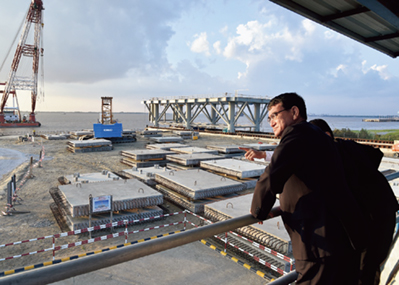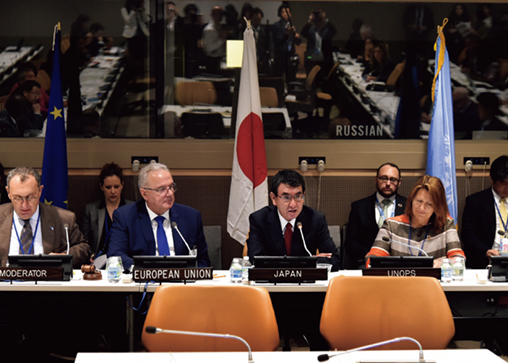Section 3 Promoting “Quality Infrastructure” Development

Foreign Minister Taro Kono on an inspection tour of the Thilawa Special Economic Zone in Yangon, Myanmar, in January 2018
When developing infrastructure, the objective should be not to create the infrastructure itself, but rather, through its development, to contribute to improving the lives of people in the region, including the socially vulnerable, and stimulate economic activity in the country and region, and support “quality growth” in each country. With this understanding, Japan is promoting the development of “quality infrastructure” and is working to contribute to its international standardization. The following five elements for “quality infrastructure” were set out at the 2016 G7 Ise-Shima Summit: (i) economic efficiency and safety in view of lifecycle cost; (ii) local employment and transfer of technology; (iii) social and environmental consideration; (iv) alignment with economic and development strategies, including the financial soundness of recipient countries; and (v) ensuring effective resource mobilization, including the private sector. In addition, it is also vital to carry out development and management infrastructure through transparent and fair procurement procedures so that infrastructure is open for everyone to use.
There is great demand for infrastructure development around the world, including in the Indo-Pacific region, and it is important to secure not only quality, but also an adequate amount of funds. To fill this funding gap, Prime Minister Abe announced the “Partnership for Quality Infrastructure” in May 2015, under which Japan would cooperate with the Asian Development Bank (ADB) to provide “quality infrastructure investments” worth approximately $110 billion to Asia over five years. At the same time, Japan decided to improve the ODA loan system to provide even more attractive financing towards infrastructure demand in Asia. Furthermore, in May 2016, Prime Minister Abe announced the “Expanded Partnership for Quality Infrastructure,” a program that aims to supply approximately $200 billion in funds from both the public and private sectors, towards fulfilling infrastructure demand not only in Asia but around the world. Alongside further institutional improvements, he also announced initiatives to promote institutional reinforcements of governmental organizations that support the above-mentioned initiatives, such as JICA. As part of its efforts to expand the concept of “quality infrastructure” across the world, Japan co-hosted the First International Economic Forum on Asia with OECD in April 2017, and co-hosted the UN General Assembly High-Level Side Event: “Promoting Quality Infrastructure Investment” with the United Nations and the European Union. Going forward, Japan aims to work together with international organizations such as the OECD and relevant countries to continue promoting quality growth through the development of “quality infrastructure.”

Foreign Minister Taro Kono delivering an address at the “UN General Assembly High-Level Side Event: Promoting Quality Infrastructure Investment” co-hosted by Japan, EU, and UN, at the UN Headquarters in New York in September 2017
